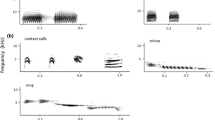Summary
We studied interspecific alarm communication between two species of social wasps in a nesting association in northwestern Costa Rica by testing the alarm responses ofPolybia occidentalis andMischocyttarus immarginatus to venom of both species. This is the first investigation of alarm pheromone in the genusMischocyttarus. M. immarginatus did not respond with alarm behavior to the venom of either species.P. occidentalis, which responds to its own venom with alarm behavior (Jeanne, 1981), also responded with alarm behavior to the venom ofM. immarginatus, but with much less intensity. Since heterospecific venoms did not release species-typical levels of alarm behavior, we conclude that interspecific alarm signalling plays no role in the nesting association.
Similar content being viewed by others
References
Freisling, J., 1943. Zur Psychologie der Feldwespe.Z. Tierpsychol. 5:438–463.
Gorton, R. E., 1978. Observations on the nesting behavior ofMischocyttarus immarginatus (Rich.) (Vespidae: Hymenoptera) in a dry forest in Costa Rica.Ins. Soc. 25:197–204.
Hölldobler, B. and E. O. Wilson, 1990.The Ants. The Belknap Press of Harvard University Press, Cambridge, Mass. 732 pp.
Jeanne, R. L., 1981. Alarm recruitment, attack behavior, and the role of the alarm pheromone inPolybia occidentalis (Hymenoptera: Vespidae).Behav. Ecol. Sociobiol. 9:143–148.
Jeanne, R. L., 1982. Evidence for an alarm substance inPolistes canadensis.Experientia 38:329–330.
Jeanne, R. L., 1991. The Swarm-founding Polistinae. In:The Social Biology of Wasps (K. G. Ross and R. W. Matthews, Eds.), Cornell University Press, Ithaca, NY. pp. 191–231.
Keeping, M. G., 1995. Absence of chemical alarm in a primitively eusocial wasp (Belonogaster petiolata, Hymenoptera: Vespidae).Ins. Soc. 42:317–320.
Maschwitz, U., 1964. Gefahrenalarmstoffe und Gefahrenalarmierung bei sozialen Hymenopteren.Z. vergl. Physiol. 47:596–655.
Post, D. C., H. A. Downing and R. L. Jeanne, 1984. Alarm response to venom by social waspsPolistes exclamans andPolistes fuscatus (Hymenoptera: Vespidae).J. Chem. Ecol. 10:1425–1433.
Starr, C. K., 1988. The nesting association of the social waspsMischocyttarus immarginatus andPolybia spp. in Costa Rica.Biotropica 20:171–173.
Wilson, E. O., 1971.The Insect Societies. The Belknap Press of Harvard University Press. Cambridge, Mass. 548 pp.
Windsor, D. M., 1972. Nesting association between two neotropical polybiine wasps (Hymenoptera, Vespidae).Biotropica 4:1–3.
Author information
Authors and Affiliations
Rights and permissions
About this article
Cite this article
London, K.B., Jeanne, R.L. Alarm in a wasp-wasp nesting association: Do members signal cross-specifically?. Ins. Soc 43, 211–215 (1996). https://doi.org/10.1007/BF01242572
Received:
Revised:
Accepted:
Issue Date:
DOI: https://doi.org/10.1007/BF01242572




